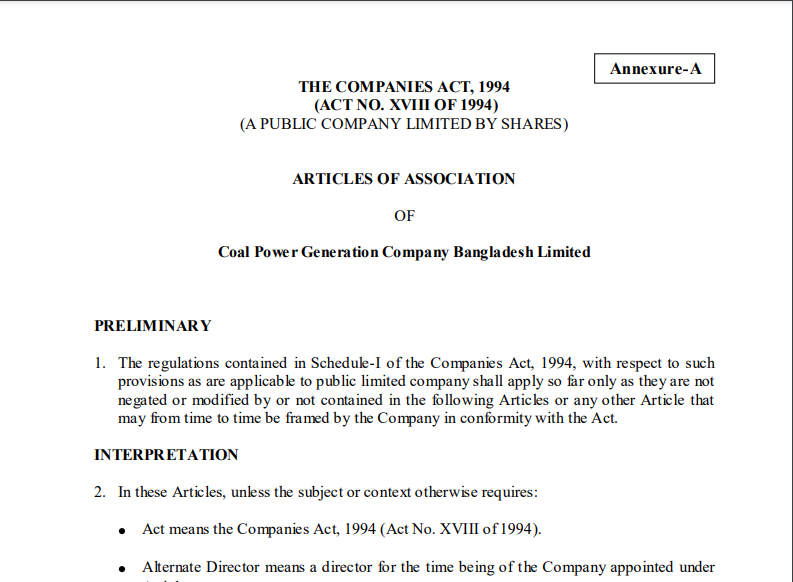Boards of companies, both public and private, are seen as power centres of a corporate entity. Hence, it is commonly seen that corporate disputes are often invoked out of and revolve around a certain section of shareholders seeking to seize directorship positions favouring the counter-set of shareholders.
The directors and shareholders are the same individuals. Even if a director is removed from his directorship, he will still be considered a shareholder of that very company.
Process of Forcing a Director to Resign but Remain as a Shareholder
In Bangladesh, forcing a director to resign while allowing them to retain their status as a shareholder involves a series of legal steps and considerations.
This typically includes reviewing the company’s Articles of Association, gathering shareholder support, convening a general meeting, passing a special resolution for the director’s removal, informing the director officially, and updating statutory registers.
Directors can be removed under the Companies Act of 1994 through extraordinary or ordinary resolutions, disqualification by specific criteria, or vacation of office.
Despite being removed as directors, individuals retain their shareholder rights and may challenge the decision. Seeking legal advice and drafting a shareholder agreement are crucial aspects of this process to ensure compliance and protect rights.
In Bangladesh, forcing a director to resign while allowing them to remain as a shareholder typically involves several steps and legal considerations. Here is a general outline of the process:
Review the Company’s Articles of Association:
The first step is to carefully examine the company’s Articles of Association. This document outlines the internal rules and regulations governing the company’s operations, including provisions related to director resignation and removal.
Gather Sufficient Shareholder Support:
To force a director’s resignation, you will typically need the support of a significant majority of shareholders. This can be achieved by engaging with other shareholders and persuading them to vote in favour of the director’s removal.
Convene a General Meeting:
Once you have obtained sufficient shareholder support, you need to formally convene a general meeting of the company. The specific requirements for calling a meeting can be found in the Articles of Association and the Companies Act of Bangladesh.
Pass a Special Resolution:
During the general meeting, a special resolution needs to be proposed and passed, specifically addressing the removal of the director. The resolution should clearly state the intention to accept the director’s resignation while allowing them to retain their shareholding.
Inform the Director:
After the special resolution is passed, the company must officially inform the director about the decision. This can be done through a formal notice, preferably in writing, stating the outcome of the general meeting and the director’s subsequent resignation.
Amend the Director’s Status:
The director’s resignation should be recorded in the company’s statutory registers, including the Register of Directors. It is also important to update any relevant government authorities and regulatory bodies about the change in directorship.
Shareholder Agreement:
It is advisable to consult a legal professional to draft a shareholder agreement that clearly outlines the rights and obligations of the director as a shareholder, ensuring their continued involvement in the company’s affairs while relinquishing their directorial role.
Obtain Legal Advice:
It is highly recommended to seek legal advice throughout the process to ensure compliance with the Companies Act, the Articles of Association, and any other relevant laws and regulations in Bangladesh.
Directors may be forced to resign from their offices either based on disqualification or due to circumstances leading to the vacation of office or removed by passing the extraordinary and ordinary resolution in the annual general meeting through other directors.
Mainly, there are three main ways to remove a director:
- Under the company’s Articles of Association (AoA),
- Using the statutory procedures of the Companies Act, 1994,
- Through disqualification by a third party, such as a court.
Disqualification:
Under the Companies Act of 1994, a director is disqualified if-
- unsound mind by a competent court or other authority,
- undischarged insolvent,
- applied to be adjudicated as insolvent and his application is pending,
- has not paid any calls in respect of shares of the company held by him,
- a minor.
- the company may add additional grounds in its articles for the disqualification of a director.
Removal:
Under the Companies Act of 1994, a director is removed if
- Extraordinary Resolution: through the extraordinary resolution, the company remove any share-holder director before the expiration of his period of office,
- Ordinary Resolution: through ordinary resolution, the company can appoint another person in his/her stead and the person so appointed shall be subject to retirement at the same time as if he/she has become a director on the day on which the director in whose place he/she is appointed was last elected director.
Re-appointment:
A director once removed shall not be re-appointed as “a director” by the Board of Directors.
Vacation of Office:
Under the Companies Act of 1994, a director can be removed by vacating the office of director on the following grounds-
(a) She/he fails to obtain or ceases to hold, the qualifications,
(b) She/he is found to be of unsound mind by a competent court,
(c) She/he is adjudged insolvent,
(d) She/he fails to pay calls made on her/him in respect of shares held by her/him within six months from the date of such calls being made,
(e) She/he or any firm of which she/he is a partner or any private company of which she/he is a director, without the sanction of the company in general meeting accepts or holds any office of profit under the company,
(f) She/he absents himself from three consecutive meetings of the directors or all meetings of the directors for a continuous period of three months, whichever is longer, without leave of absence from the Board of Directors,
(g) She/he or any firm of which she/he is a partner or any private company of which he is a director accepts a loan or guarantee from the company,
(h) She/he enters into any contract for the sale, purchase or supply of goods and materials with the company.
(i) A company may provide by its articles that the office of the director shall be vacated on grounds additional to those specified above.
Lastly, the director is a shareholder of a company. The other directors can force a director to resign based on the above-mentioned grounds but it won’t cease the director’s right as a shareholder.
As the director is also a shareholder, they can use the provisions of the Companies Act to challenge the decision to remove them. For example, the director may claim that they are an integral part of the management of the company, particularly if the business operates as a partnership. Therefore any attempt to remove them may prejudice their rights as a shareholder.
Need Any Legal Help?
Counsels Law Partners (CLP) offers services on the companies’ registration, establishment and other related matters. However, if you need any legal help or clarification about the companies’ registration, establishment and other related matters, please reach us at:
E-mail:info@counselslaw.com
Phone: +8801700920980 (WhatsApp). +8801947470606.
Address: Jamila Villa, Flat No. C-2, House-4/A/1 (3rd Floor),
Road-02, Gulshan-1, Dhaka-1212, Bangladesh.




